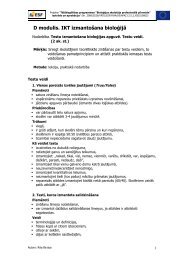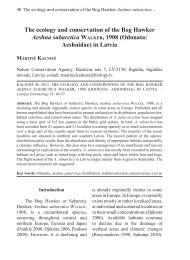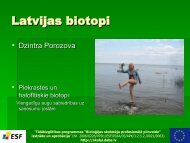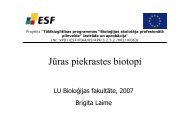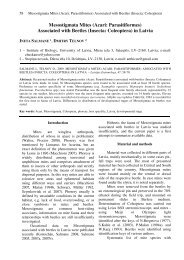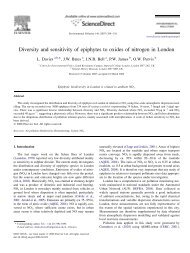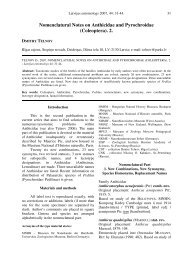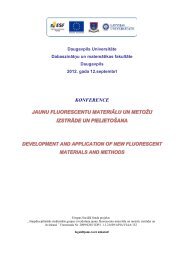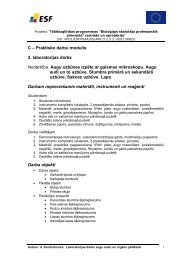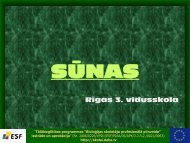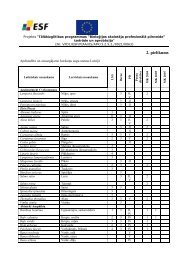Odonata - Entomological Society of Latvia - Latvijas Daba
Odonata - Entomological Society of Latvia - Latvijas Daba
Odonata - Entomological Society of Latvia - Latvijas Daba
You also want an ePaper? Increase the reach of your titles
YUMPU automatically turns print PDFs into web optimized ePapers that Google loves.
strongly preferred. Additionally, at two localities, C. elata was the leading species in the habitat <strong>of</strong><br />
N. speciosa. Apart from other typical components <strong>of</strong> the sedgling's habitats, e.g. Sphagnum sp.,<br />
Utricularia sp., Menyanthes trifoliata, Comarum palustre, Naumburgia thyrsiflora, Equisetum<br />
limosum (De Marmels, Schiess 1977; Schmidt, Sternberg 1999 etc.), some rather untypical plant<br />
species occur, such as Thelypteris palustris, Typha latifolia and Hydrocharis morsus-ranae.<br />
Anthropogenic, habitats play a rather marginal role in the habitat spectrum <strong>of</strong> N. speciosa in<br />
<strong>Latvia</strong>. These localities may have long-term significance for N. speciosa as bogs occupy large areas<br />
and probably always included a mosaic <strong>of</strong> habitats, from active peaty post-excavation places to<br />
active raised bogs. It means that in such peat bogs, suitable habitats for N. speciosa can be<br />
established during the succession proccesses.<br />
Current data shows that large populations are rare, but small populations are the most<br />
frequent. This situation is typical for all the Baltic States (Bernard and Wildermuth 2005).<br />
Aeshna subarctica. A subarctica is a Holarctic species. However, the main species' European<br />
range is around the Baltic Sea (Dijkstra 2006; Skvortsov 2010). Current distribution pattern probably<br />
results in part from the diverse intensity <strong>of</strong> odonatological studies in various regions. An analysis <strong>of</strong><br />
a potential basis for such a pattern has not revealed a clear cause as the known distribution <strong>of</strong><br />
A. subarctica does not correlate with the delineation <strong>of</strong> <strong>Latvia</strong> into physiographic regions (sensu<br />
Ramans, Zelčs 1995) or geobotanical regions (sensu Kabucis 1995). However, the richness and<br />
abundance <strong>of</strong> raised bogs, thus potential habitats <strong>of</strong> the species, undoubtedly result in greater<br />
numbers and concentration <strong>of</strong> its localities. This general correlation is especially recognizable from<br />
the example <strong>of</strong> western <strong>Latvia</strong>, occupied by a large raised bog district which is a part <strong>of</strong> a great<br />
mires chain extending through several countries. Some correlation between the distribution <strong>of</strong><br />
A. subarctica and climatic regionalisation (sensu Kalniņa 1995) has also been recognisable as the<br />
majority <strong>of</strong> known localities (90 %) are situated in two climatic regions (Figure 19). These climatic<br />
regions are characterized by a higher humidity (hydrothermal coefficient 1.6–2.4) and a more<br />
continental climate in comparison with other two climatic regions (Kalniņa 1995).<br />
In comparing the habitats inhabited by A. subarctica in <strong>Latvia</strong> and other Europe, some<br />
differences were found. Some authors write that species inhabited active raised bogs with pools<br />
with immerged (floating) Sphagnum (Dijkstra 2006), others mentioned that species was found in<br />
post excavation peaty pools (Scholl 2001). In <strong>Latvia</strong> A. subarctica has been found in raised bogs<br />
with water pools and lakes, as well as in lakes with fens and poor fens, but not found in any <strong>of</strong> the<br />
surveyed post-excavation peat pools. If compare the water courses where larvaes was found or egg<br />
laying observed, it seems that these water courses are larger than 25 m 2 . This concurrent with<br />
observations in Czech Republic, were the species are occurring in small (ca. 50 m 2 ) peat pools and<br />
large (ca. 1000 m 2 ) peat lakes, but most abundant in pools with surface ca. 300 m 2 (Holuša 2000).<br />
However in Germany egg laying and exuviae’s was observed in small pits made by red deer Cervus<br />
elaphus and wild boar Sus scr<strong>of</strong>a (Bönsel 1999).<br />
The species composition <strong>of</strong> vegetation at <strong>Latvia</strong>n localities is frequently relative poor.<br />
Floating Sphagnum cuspidatum is the most frequent and the most abundant representative <strong>of</strong> the<br />
mosses preferred for egg laying by A. subarctica. Other Sphagnum species as Sph. Magellanicum<br />
and Sph. rubellum, though generally slightly rarer and less abundant, is also selected for egg laying<br />
by the subarctic hawker. Apart from other typical components <strong>of</strong> the subarctic hawker’s habitats<br />
(for emergence), e.g. Eriophorum sp., Rhynchospora alba, Scheuchzeria palustris, Andromeda<br />
polifolia, some rather untypical plant species occur, such as Carex limosa, and C. lasiocarpa.<br />
Although Holuša (2000) mentioned, that egg laying (and found exuviae) in Carex paupercule zone<br />
were observed.<br />
Although A. subarctica is not found in anthropogenic habitats, e.g. post-excavation peaty<br />
pools, suitable microhabitats were found in several surveyed places. It means that in such peat bogs<br />
suitable habitats for A. subarctica can be established during the succession process.<br />
74



